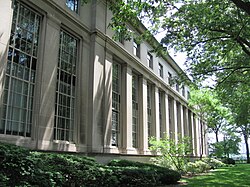 MIT Building 1 Pierce Engineering Laboratory | |
| Established | 1932 |
|---|---|
| Dean | Anantha Chandrakasan |
| Location | Cambridge , Massachusetts , United States 42°21′29″N71°05′33″W / 42.35806°N 71.09250°W |
| Website | engineering.mit.edu |
 | |
The MIT School of Engineering (SoE) is one of the five schools of the Massachusetts Institute of Technology, located in Cambridge, Massachusetts, United States. It was established in 1932 as part of the reorganization of the Institute recommended by President Karl Taylor Compton. SoE has eight academic departments and two interdisciplinary institutes. The School grants SB, MEng, SM, engineer's degrees, and PhD or ScD degrees. As of 2017 [update] , the Dean of Engineering is Professor Anantha Chandrakasan. The school is the largest at MIT as measured by undergraduate and graduate enrollments and faculty members. [1]
